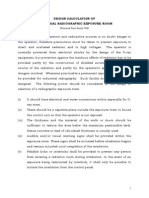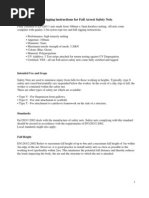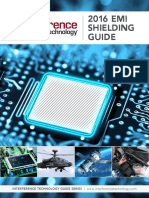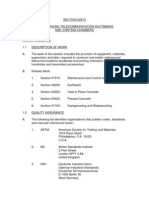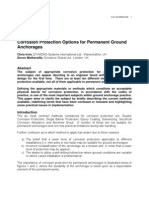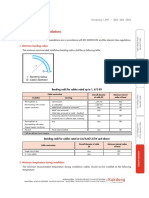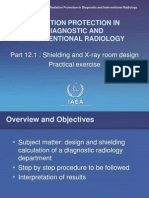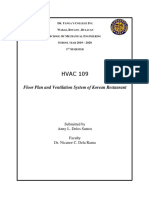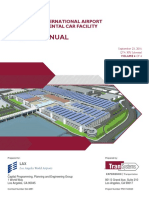0 ratings0% found this document useful (0 votes)
65 viewsPlans - 2004
Plans - 2004
Uploaded by
jopacameRadiation Shielding Requirements for Diagnostic x-ray Facilities in Western Australia. Typically, 15 kg m -2 (1. Mm) sheet lead or its shielding equivalent is specified. Screen must extend from the floor to a height of not less than 2 m and be wide enough (> 90 cms) to protect the operator from leakage radiation from the tube housing and scattered radiation from the patient.
Copyright:
© All Rights Reserved
Available Formats
Download as PDF, TXT or read online from Scribd
Plans - 2004
Plans - 2004
Uploaded by
jopacame0 ratings0% found this document useful (0 votes)
65 views5 pagesRadiation Shielding Requirements for Diagnostic x-ray Facilities in Western Australia. Typically, 15 kg m -2 (1. Mm) sheet lead or its shielding equivalent is specified. Screen must extend from the floor to a height of not less than 2 m and be wide enough (> 90 cms) to protect the operator from leakage radiation from the tube housing and scattered radiation from the patient.
Original Title
plans - 2004
Copyright
© © All Rights Reserved
Available Formats
PDF, TXT or read online from Scribd
Share this document
Did you find this document useful?
Is this content inappropriate?
Radiation Shielding Requirements for Diagnostic x-ray Facilities in Western Australia. Typically, 15 kg m -2 (1. Mm) sheet lead or its shielding equivalent is specified. Screen must extend from the floor to a height of not less than 2 m and be wide enough (> 90 cms) to protect the operator from leakage radiation from the tube housing and scattered radiation from the patient.
Copyright:
© All Rights Reserved
Available Formats
Download as PDF, TXT or read online from Scribd
Download as pdf or txt
0 ratings0% found this document useful (0 votes)
65 views5 pagesPlans - 2004
Plans - 2004
Uploaded by
jopacameRadiation Shielding Requirements for Diagnostic x-ray Facilities in Western Australia. Typically, 15 kg m -2 (1. Mm) sheet lead or its shielding equivalent is specified. Screen must extend from the floor to a height of not less than 2 m and be wide enough (> 90 cms) to protect the operator from leakage radiation from the tube housing and scattered radiation from the patient.
Copyright:
© All Rights Reserved
Available Formats
Download as PDF, TXT or read online from Scribd
Download as pdf or txt
You are on page 1of 5
Radiation Shielding Requirements for Diagnostic X-ray Facilities Western Australia
Radiation Health Branch plans.doc\Nov 2004 Page 1
GENERAL SHIELDING REQUIREMENTS FOR DIAGNOSTIC X-RAY FACILITIES
1. PROTECTIVE SCREENS
(a) Major Medical (Radio/Fluoro/CT/Cardiac/Chiropractic)
Typically, 15 kg m
-2
(1.3 mm) sheet lead or its shielding equivalent is specified.
This may need to be higher if the protective screen is less than 2 m from either x-ray
tube or patient. Other requirements include:
sheet lead must be supported on both sides such as a ply-lead-ply sandwich or
similar to prevent creeping under gravity. Sheets must be overlapped to
ensure continuous shielding or butt jointed with an overlapping lead strip. A
permanent label must indicate the thickness of lead in the protective screen.
the screen must extend from the floor to a height of not less than 2 m and be
wide enough (> 90 cms) to protect the operator from leakage radiation from
the tube housing and scattered radiation from the patient. Side protective
shields may be required.
the protective window needs to contain the same lead equivalence and have
dimensions > 30 cm x 30 cm so that the radiographer can observe the patient
during an x-ray exposure. Generally the protective window is either lead glass
(nominal thickness 6 mm, 1.5 mm lead equivalence) or H-22 lead acrylic (1.0
mm lead equivalence at 100 kVp). All shielding must overlap by a minimum
5 mm. A permanent label indicating the lead equivalence of the window at a
nominal kVp is required.
the screen is to be secured to either the floor or wall so that the location of the
protective screen is fixed. Although fixed in position for everyday use, the
screen may be hinged for service access to controls. A small gap (< 5 cm)
between the floor and screen for castors is permitted.
b) Mammography
Protective screen needs to be at least 0.3 mm lead equivalence at 30 kVp.
2. WALLS
(a) Major Medical (Radio/Fluoro/CT/Cardiac/Chiropractic)
For installations other than CT, shielding equivalent to at least 1 mm lead at
100 kVp is required. A choice of building materials is available to achieve this
degree of shielding, including a single layer of solid clay brick with fully mortared
joints, two thicknesses of ordinary cored brick, 15 kg m
-2
sheet lead (suitably
supported and overlapped) or two layers (2 x 16 mm) of barium plaster x-ray
Radiation Shielding Requirements for Diagnostic X-ray Facilities Western Australia
Radiation Health Branch plans.doc\Nov 2004 Page 2
panels
1
. For CT installations, shielding equivalent to 1.5 mm lead or more may be
required.
Protection needs to extend from the floor to a height of not less than 2 m and be
continuous. Where recessed wall boxes such as GPOs and medical gas panels are
installed, sufficient shielding must be added to maintain the level of shielding
provided by the rest of the wall.
(b) Mammographic
Typically 0.3 mm lead equivalence protection at 30 kVp.
(c) Dental Cephalometric
Typically 0.5 mm lead equivalence protection at 100 kVp.
(d) Dental (Intraoral/OPG)
Typical building materials, including double gyprock walls, are generally sufficient
provided all personnel maintain at least the minimum permitted distance of 2 m
from the x-ray tube and the patient during exposures.
3. DOORS
Shielding may only be required for major medical installations. 10 kg m
-2
sheet lead is
generally satisfactory unless the area outside the door is likely to have reasonably
continuous occupancy, e.g. if the area is an office, film sorting / processing area. The
doors to CT rooms should generally not have less than 15 kg m
-2
lead.
Where radiation protection is requested for doors, the frames are excluded from this
requirement. It is sufficient that the steel door frame be detailed to overlap the wall
structure for the necessary protection to be achieved.
Warning lights at room entrances may be required for fixed general purpose, fluoroscopic
or CT equipment where entry is not directly under the equipment users control. Where
required, warning lights (Caution x-rays) should be mounted alongside the entrance
and connected into the x-ray generator circuit so that they illuminate at prep and for the
duration of the exposure.
4. FLOORS / CEILINGS
Generally, 150 mm solid concrete provides sufficient shielding between floors of multiple
storey buildings.
1
The only approved and tested barium plaster boards are those manufactured by Bradys Building Products. For
1 mm lead equivalence at 100 kVp, 2 x 16 mm R40 panels must be used, with joints offset.
Radiation Shielding Requirements for Diagnostic X-ray Facilities Western Australia
Radiation Health Branch plans.doc\Nov 2004 Page 3
5. VERTICAL BUCKY / CASSETTE HOLDERS
Except for walls equivalent to at least 1.4 mm lead, an additional protective panel may be
specified for use behind the vertical bucky, depending on the occupancy of the adjoining
area. This is generally 15 kg m
-2
sheet lead, suitably supported and overlapped. If
required, the panel needs to extend from the floor (although up to 30 cm from the floor
will be permitted) to a height of around 200 cm and extend 30 cm either side of the
vertical bucky. The protective panel may be attached to the wall with the vertical bucky
supports provided its presence is obvious and there is no risk of physical injury to anyone
dismantling the vertical bucky.
6. DARKROOM PASS HATCHES
Film pass hatch between the x-ray room and dark room must be lined with 15 kg m
-2
sheet
lead, suitably supported and overlapped. The shielding must be on the x-ray room side of
the pass hatch.
7. BONDING METHODS FOR SHEET LEAD
Sheet lead is incapable of supporting itself and will tear and fall under gravity if not
bonded to a suitable substrate. A rigid glue (such as araldite or wall bond adhesive) that
does not permit creep under gravity is required. Rubber based contact cements are
generally unsuitable. The best method of attaching sheet lead to a supportive substrate is
to glue it under pressure in a press similar to a door press. Sheet lead may be glued to
chipboard, custom board, plywood, plastic laminate sheeting, galvanised steel sheet or
aluminium sheet.
Sheet lead can be incorporated into a metal stud wall clad with gyprock wall board by
gluing it to thin galvanised steel sheet, fastening to the metal studs and then covering with
gyprock sheet. Fastening holes such as those produced by screws through the sheet lead
and wall board into the metal studs are permitted, provided the screws are in place. Sheet
lead glued to chipboard or similar substrate may be covered with a glued layer of a
laminate or similar which becomes the final wall finish or the lead side can be placed
against the wall studs with laminate on the outside.
8. GENERAL
Each x-ray installation must be assessed for shielding requirements based on the:-
dimensions of the room
positions of the x-ray control, vertical bucky and operator
proposed construction materials (protective screens, walls, floors, doors)
areas adjacent to x-ray room (occupancy, future use)
x-ray workload
Structural protection plans must be supplied to the Radiological Council prior to
construction or for existing buildings prior to use of the x-ray equipment in the room.
Radiation Shielding Requirements for Diagnostic X-ray Facilities Western Australia
Radiation Health Branch plans.doc\Nov 2004 Page 4
9. RESPONSIBILITIES
All premises where the x-ray equipment is used must be registered. The possession and
use of x-ray equipment without a registration is an offence under the Radiation Safety Act.
The future registrant is responsible for ensuring appropriate plans (for structural shielding
approval) and other relevant details are provided to the Radiological Council so that the
application for registration can be properly assessed. Registration must be approved prior
to any use of the equipment.
Registrants modifying premises (e.g. new equipment, relocation of existing equipment,
structural shielding changes) must provide PRIOR NOTICE in writing to the
Radiological Council of their plans and obtain the necessary approval.
Contact: The Secretary
Radiological Council
Locked Bag 2006 P O
NEDLANDS W A 6009
Tel (08) 9346 2260
Fax (08) 9381 1423
Radiation Shielding Requirements for Diagnostic X-ray Facilities Western Australia
Radiation Health Branch plans.doc\Nov 2004 Page 5
SHIELDING PROPERTIES OF COMMON BUILDING MATERIALS
BROAD BEAM CONDITIONS AT 100 kVp
Material Thickness
(mm)
Pb equivalence
(mm)
Transmission
(%)
Concrete (solid) 100 1.5 0.20
Concrete (solid) 150 2.4 0.021
Concrete (aerated) 150 0.55 3.0
Brick (solid) 110 1.5 0.20
Brick (cored) 90 0.41 5.3
Brick (cored) 110 0.71 1.8
Brick (cored) 150 1.5 0.20
Lead sheet (15 kg m
-2
) 1.3 1.3 0.30
Lead sheet (10 kg m
-2
) 0.88 0.88 1.1
Plasterboard (2 sheets of 13 mm gyprock) 26 0.15 20
Plasterboard (2 sheets of R40 barium board) 32 1.1 0.50
Lead glass 5 1.7 0.11
Lead glass 7 2.3 0.024
Lead acrylic (H-22) 22 1.1 0.56
Plate glass 25 0.21 14
Plate glass 48 0.46 4.3
Steel 1 0.15 20
Steel 2 0.30 8.6
Steel 3 0.44 4.6
NOTES
1. This table is compiled from RHB studies, HPAs Notes on Building Materials and
References on Shielding Date for Use below 300 kVp, and Sutton and Williams
Radiation Shielding for Diagnostic X-rays.
CONTACT
For further information, please contact:
Radiation Health Branch
Environmental Health Directorate
Department of Health
18 Verdun Street
Nedlands WA 6009
Tel (08) 9346 2260
Fax (08) 9381 1423
e-mail radiation.health@health.wa.gov.au
You might also like
- Anna Bhau Sathe Auditorium, YerwadaDocument17 pagesAnna Bhau Sathe Auditorium, YerwadaRadhika AgarwalNo ratings yet
- Chiro Shielding Guidelines Feb 14Document2 pagesChiro Shielding Guidelines Feb 14jopacameNo ratings yet
- Cable LayoutsDocument22 pagesCable LayoutsSomnath Das100% (2)
- Chiro Shielding Guidelines Feb 14Document2 pagesChiro Shielding Guidelines Feb 14jopacameNo ratings yet
- King Post Truss Joinery Analysis PDFDocument29 pagesKing Post Truss Joinery Analysis PDFAman ulla jinnahNo ratings yet
- Diagnostic Radiology Structural Shielding RequirementsDocument5 pagesDiagnostic Radiology Structural Shielding Requirementszekariyas sintayehuNo ratings yet
- Extracted Pages From Radiotion ProtectionDocument4 pagesExtracted Pages From Radiotion ProtectionDaniel EkassiNo ratings yet
- Radiation Shielding Requirements For Diagnostic X Ray FacilitiesDocument8 pagesRadiation Shielding Requirements For Diagnostic X Ray FacilitiesGreg NavarreteNo ratings yet
- 41.is25 - General Guidance On Shielding Requirements For Medical X-Ray Diagnostic RoomsDocument2 pages41.is25 - General Guidance On Shielding Requirements For Medical X-Ray Diagnostic RoomsMuzri MuhammoodNo ratings yet
- Pub7 EnglishDocument12 pagesPub7 EnglishjopacameNo ratings yet
- Barriers in Radiology.Document3 pagesBarriers in Radiology.Tarun AroraNo ratings yet
- ds139 e Cui Conductor PDFDocument8 pagesds139 e Cui Conductor PDFEkoFujisyahMaulwantoNo ratings yet
- 41.is25 - General Guidance On Shielding Requirements For Medical X-Ray Diagnostic RoomsDocument2 pages41.is25 - General Guidance On Shielding Requirements For Medical X-Ray Diagnostic Roomsjopacame100% (1)
- Chapter 3 Datasheets Roof PanelsDocument16 pagesChapter 3 Datasheets Roof PanelsMladen BilincNo ratings yet
- Switch Receiver and Transmitters: Safety InstructionsDocument2 pagesSwitch Receiver and Transmitters: Safety Instructionssaleh67msNo ratings yet
- Lead Shielding Requirements When Building X-Ray RoomDocument6 pagesLead Shielding Requirements When Building X-Ray Roomnuclead100% (1)
- Design Calculation of Industrial Radiographic Exposure Room: Mohamad Pauzi Ismail, PHDDocument22 pagesDesign Calculation of Industrial Radiographic Exposure Room: Mohamad Pauzi Ismail, PHDmusaismail8863No ratings yet
- Shielding Design GeneralDocument22 pagesShielding Design GeneralAbu OmarNo ratings yet
- Ruukki 41338 Instructiuni de Montaj Placarea Fatadei Peste PanouriDocument12 pagesRuukki 41338 Instructiuni de Montaj Placarea Fatadei Peste PanouriGhenoiu PaulNo ratings yet
- Single Core Cables To IEC 60502Document12 pagesSingle Core Cables To IEC 60502rose chen100% (2)
- Share 'Compliance 5-6-7 ADSS FiberDocument6 pagesShare 'Compliance 5-6-7 ADSS FiberShashank SaxenaNo ratings yet
- Specification of Safety NetDocument5 pagesSpecification of Safety Netdeepak_023100% (1)
- Acoustic Treatment For Mri RoomsDocument6 pagesAcoustic Treatment For Mri RoomsthiagoraraujoNo ratings yet
- 036 PEC ArticleDocument7 pages036 PEC Articlemahesh070100% (1)
- Rockwool Intumescent PillowsDocument3 pagesRockwool Intumescent PillowsBobana AdamovicNo ratings yet
- conduit installation guideDocument8 pagesconduit installation guidemahreenanam189No ratings yet
- Three Core Cables To BS 6622Document8 pagesThree Core Cables To BS 6622rose chenNo ratings yet
- 2016 IT - Sheilding Guide PDFDocument40 pages2016 IT - Sheilding Guide PDFlazarosNo ratings yet
- Univ Xray RoomDocument7 pagesUniv Xray RoomTC Nihal AlcansoyNo ratings yet
- Designing The X-Ray Room and Dark RoomDocument11 pagesDesigning The X-Ray Room and Dark Roomimmortalneo100% (4)
- DSI Bonded PT System Strands enDocument32 pagesDSI Bonded PT System Strands enElvisyuriNo ratings yet
- AERB Shielding GuidelinesDocument4 pagesAERB Shielding GuidelinesTejinder SinghNo ratings yet
- Post Tensioning SystemDocument13 pagesPost Tensioning SystemAbhijit JadhavNo ratings yet
- Three Core Cables To IEC 60502Document16 pagesThree Core Cables To IEC 60502rose chenNo ratings yet
- Specification of Lightning Protection Based On BSEN 62305Document8 pagesSpecification of Lightning Protection Based On BSEN 62305Ayman SaberNo ratings yet
- Catalogue Solid Core PDFDocument16 pagesCatalogue Solid Core PDFtholgasenelNo ratings yet
- Techinical Specification of Polymer 11 KV & 33 KV Pin InsulatorDocument14 pagesTechinical Specification of Polymer 11 KV & 33 KV Pin InsulatordamlanNo ratings yet
- AFICO Heavy Density Pipe Insulation - NewDocument4 pagesAFICO Heavy Density Pipe Insulation - NewNickolas HeadNo ratings yet
- Duct Liner (AFICO)Document4 pagesDuct Liner (AFICO)hshoooma65No ratings yet
- Crack ArrestorDocument14 pagesCrack ArrestorJulia WadeNo ratings yet
- U-Boot Silence Mantle For Sound InsulationDocument8 pagesU-Boot Silence Mantle For Sound InsulationDaliform GroupNo ratings yet
- Acoustic Plaster 2022.RAMDocument13 pagesAcoustic Plaster 2022.RAMArnoldo Schreiber JrNo ratings yet
- Grounding and Overvoltage Protection IP 16-4-1: ScopeDocument11 pagesGrounding and Overvoltage Protection IP 16-4-1: ScopeMara LiceoNo ratings yet
- Ductwork SystemDocument8 pagesDuctwork SystemrkssNo ratings yet
- XHC-000-Rev 2.0 T3 Precision Pre-Installation Requiements DocumentDocument13 pagesXHC-000-Rev 2.0 T3 Precision Pre-Installation Requiements DocumentBill MtsyNo ratings yet
- Elce4012 5Document14 pagesElce4012 5ameerNo ratings yet
- Telecom Duct BanksDocument16 pagesTelecom Duct Bankssethu1091100% (1)
- Tech Bulletin 4 Cladding InstallationDocument4 pagesTech Bulletin 4 Cladding InstallationAbu NijamNo ratings yet
- Slip MembraneDocument1 pageSlip MembranescchungNo ratings yet
- 3m qtII 5623kDocument4 pages3m qtII 5623kcerachuckNo ratings yet
- DSI UK Corrosion Protection Options For Permanent Ground Anchorages ENGDocument11 pagesDSI UK Corrosion Protection Options For Permanent Ground Anchorages ENGsecanet10No ratings yet
- CRP BSL2 TRIVANDRUM BOQDocument2 pagesCRP BSL2 TRIVANDRUM BOQNoaman ShaikhNo ratings yet
- Ma & Ls Range: Carl Zeiss SMT - Nano Technology Systems DivisionDocument6 pagesMa & Ls Range: Carl Zeiss SMT - Nano Technology Systems DivisionVidas MakareviciusNo ratings yet
- Electrical Practices-Construction and Demolition Sites Fact SheetDocument6 pagesElectrical Practices-Construction and Demolition Sites Fact SheetNajamNo ratings yet
- Radiographic Testing ProcedureDocument8 pagesRadiographic Testing ProcedureRai Singh MalhiNo ratings yet
- X-RAY ROOM DESIGN AND STRUCTURAL SHIELDINGDocument43 pagesX-RAY ROOM DESIGN AND STRUCTURAL SHIELDINGNaim KhanNo ratings yet
- JPG To TextDocument1 pageJPG To Textentertainerfacts00No ratings yet
- Piping Equipment IsolationDocument14 pagesPiping Equipment IsolationLữ Hành ShutoNo ratings yet
- Technical Information PDFDocument24 pagesTechnical Information PDFsouheil boussaidNo ratings yet
- New Sensors and Processing ChainFrom EverandNew Sensors and Processing ChainJean-Hugh ThomasNo ratings yet
- On-Chip Electro-Static Discharge (ESD) Protection for Radio-Frequency Integrated CircuitsFrom EverandOn-Chip Electro-Static Discharge (ESD) Protection for Radio-Frequency Integrated CircuitsNo ratings yet
- RPDIR-P12.1 Shielding Calculation WEBDocument22 pagesRPDIR-P12.1 Shielding Calculation WEBjopacameNo ratings yet
- 41.is25 - General Guidance On Shielding Requirements For Medical X-Ray Diagnostic RoomsDocument2 pages41.is25 - General Guidance On Shielding Requirements For Medical X-Ray Diagnostic Roomsjopacame100% (1)
- StandardDocument2 pagesStandardjopacameNo ratings yet
- Simpkin - Description of The NCRP 147 Shielding Model Using XRAYBARR SoftwareDocument59 pagesSimpkin - Description of The NCRP 147 Shielding Model Using XRAYBARR SoftwareLudwing Sanchez0% (1)
- TR Pedestal PDFDocument2 pagesTR Pedestal PDFjopacameNo ratings yet
- Formato Metrados Longitudes, Areas y VolumenesDocument1 pageFormato Metrados Longitudes, Areas y VolumenesjopacameNo ratings yet
- Chloride 80-NET: Secure Power For Mission Critical ApplicationsDocument16 pagesChloride 80-NET: Secure Power For Mission Critical ApplicationsjopacameNo ratings yet
- Logo in DetailsDocument146 pagesLogo in DetailsjopacameNo ratings yet
- A3 ALPHA Meter Data SheetDocument2 pagesA3 ALPHA Meter Data SheetjopacameNo ratings yet
- Low Cost HousingDocument35 pagesLow Cost HousingsarathNo ratings yet
- Installation of Plumbing FixturesDocument1 pageInstallation of Plumbing FixturesErlinda Remo FloraNo ratings yet
- Auroville ReportDocument35 pagesAuroville ReportIshani50% (2)
- Effect of Temperature Loads On Beam Design in Thermal AnalysisDocument4 pagesEffect of Temperature Loads On Beam Design in Thermal AnalysisMohammad AasimuddinNo ratings yet
- Project Report of Pre Engineered Steel BuildingDocument114 pagesProject Report of Pre Engineered Steel Buildinganon_10826711184% (37)
- Solar Load Through Transparent SurfacesDocument6 pagesSolar Load Through Transparent SurfacesJayson OrosaNo ratings yet
- HVAC 109: Floor Plan and Ventilation System of Korean RestaurantDocument15 pagesHVAC 109: Floor Plan and Ventilation System of Korean RestaurantReiman GarciaNo ratings yet
- Here's How ... Ceramic Tile PDFDocument98 pagesHere's How ... Ceramic Tile PDFRaghu100% (2)
- Aluminium TechnicalDocument20 pagesAluminium Technicalmarcelomac123100% (1)
- Condition Survey Form - Complex Buildings Index and Field NotesDocument30 pagesCondition Survey Form - Complex Buildings Index and Field NotesyashNo ratings yet
- Building User GuideDocument33 pagesBuilding User GuideSuryadi KurniawanNo ratings yet
- Sringeri Math EstimationDocument2 pagesSringeri Math Estimationpraven kumarNo ratings yet
- Tg-Bec 2021Document244 pagesTg-Bec 2021Alex HanNo ratings yet
- Phillips Exeter Academy LibraryDocument6 pagesPhillips Exeter Academy LibraryJuwan JafferNo ratings yet
- Case Stdy 2 - MergedDocument5 pagesCase Stdy 2 - MergedMaisieNo ratings yet
- Specifying PolystyreneDocument1 pageSpecifying PolystyrenedantranzNo ratings yet
- LAX 30 QTA - Spec Volume 4Document694 pagesLAX 30 QTA - Spec Volume 4Luis Mogrovejo100% (1)
- Brosura Trespa Meteon Tehnicna FasadeDocument48 pagesBrosura Trespa Meteon Tehnicna FasadeJurica DragicevicNo ratings yet
- Training Report - Khasa KothiDocument33 pagesTraining Report - Khasa KothiDevendra SharmaNo ratings yet
- Palm Valley International School, Meerut - MEP Concept Design Brief ReportDocument75 pagesPalm Valley International School, Meerut - MEP Concept Design Brief ReportArun Kumar GNo ratings yet
- CS Catalogo - Expansion Join Covers PDFDocument23 pagesCS Catalogo - Expansion Join Covers PDFNelson EcheverriaNo ratings yet
- Top Down ConstructionDocument15 pagesTop Down ConstructionUkhti EvHaNo ratings yet
- Midwall: Parɵ Al Wall FramingDocument2 pagesMidwall: Parɵ Al Wall FramingPaul TimkoNo ratings yet
- Prestressed Concrete: Method: Pre TensioningDocument9 pagesPrestressed Concrete: Method: Pre TensioningmohdkhalidrazaNo ratings yet
- Panch. Ghar .Amritsar 2022Document49 pagesPanch. Ghar .Amritsar 2022Amit GargNo ratings yet
- GSW BerlinDocument25 pagesGSW BerlinArtika AggarwalNo ratings yet
- Centreline Plan: Tamil Sangam, RajkotDocument1 pageCentreline Plan: Tamil Sangam, RajkotMayank PatelNo ratings yet
















